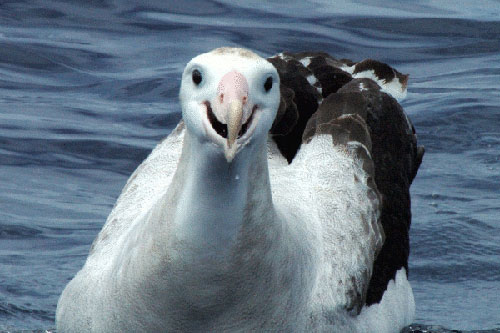Creating (and policing) Marine Protected Areas (MPAs) is one way of protecting ACAP-listed albatrosses, petrels and shearwaters from interactions with fisheries. The creation of new MPAs, some of huge size, is regularly announced, yet according to the MPA News web site so far only 1.2% of the World's oceans are so proclaimed.
In the Southern Ocean important MPAs have been proclaimed or proposed around several sub-Antarctic island groups which support breeding populations of albatrosses and petrels, including South Africa's Prince Edward Islands, Australia's Heard and MacDonald Islands and Macquarie Island and New Zealand's Auckland Islands. In the North Pacific the USA's Papahānaumokuākea Marine National Monument around the North-Western Hawaiian Islands also covers a large area patrolled by albatrosses and other seabirds.
At the recent Fifth International Albatross and Petrel Conference (IAPC5), held in New Zealand last month, Ben Lascelles of BirdLife International presented a paper that reported on progress with applying the terrestrial Important Bird Areas (IBA) concept to the marine environment, with 3000 sites so far identified for enhanced protection as MPAs.
The presentation's abstract follows:
"For more than 30 years BirdLife's Important Bird Areas (IBA) Programme has been used to help set conservation priorities in terrestrial environments. In recent years it has also been extended to include the marine environment. Over 40 BirdLife Partners are now engaged in marine IBA work worldwide, and a range of seabird experts outside of the BirdLife Partnership have helped define methodologies for using data from at-sea surveys, satellite tracking devices, habitat models and a range of other sources to identify sites in a consistent and comparable way. All these approaches have been pulled together into a "marine IBA toolkit" which provides guidance on how to approach marine IBA identification and make the most of the available data. Using these approaches BirdLife has been working towards producing the first global inventory of marine IBAs, around 3000 sites which include breeding colonies, coastal areas and pelagic sites. These sites have been successfully promoted for enhanced management and/or protection through a range of policy mechanisms such as the Convention on Biological Diversity, the European Union Birds Directive, the Nairobi Convention, the ASEAN Agreement and the Agreement for the Conservation of Albatross and Petrels."

Happy at sea in an MPA? An Antipodean Albatross smiles at the camera
Photograph by Mike Double
Participants Amélie Boué and Phil Taylor also presented co-authored papers on the role of IBAs and MPAs in protecting ACAP-listed (and other) seabirds. Their abstracts may be read in the conference booklet.
References:
Amélie Boué, Thierry Micol, Sébastien Dalloyau, Henri Weimerskirch, Karine Delord, Maite Louzao, José Manuel Arcos, David García & Beneharo Rodríguez: Use of several methods to identify marine IBAs for the Critically Endangered Balearic Shearwater. O3.
Ben Lascelles, Phil Taylor & Mark Miller: BirdLife's marine IBA Programme: progress, plans and outputs. O53.
Phil Taylor, Mark Miller & Ben Lascelles. Identifying marine IBAs from seabird tracking data. O14.
John Cooper, ACAP Information Officer, 9 September 2012

 English
English  Français
Français  Español
Español